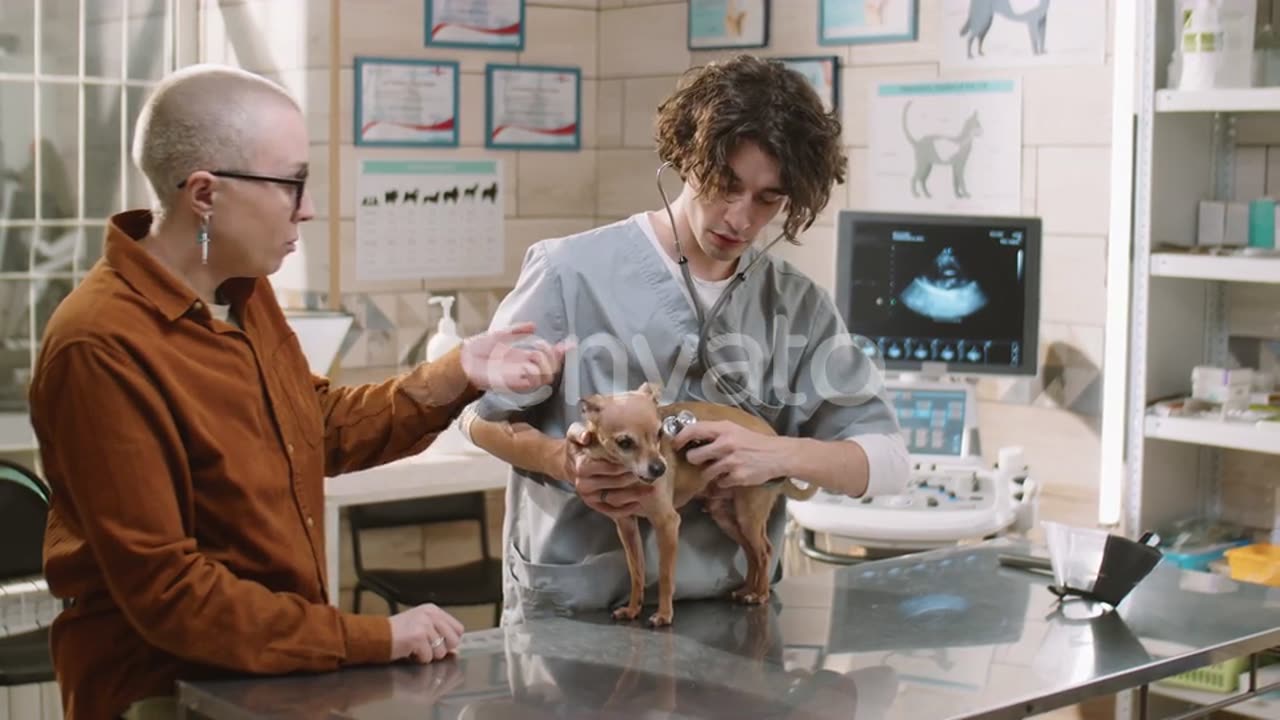Premium Only Content

Veterinarian Giving Checkup to Dog in Clinic
@doghelp
As a veterinarian, when giving a checkup to a dog in a clinic, there are several steps you would typically follow to ensure a thorough examination. Here's an outline of the process:
1. Greeting and history: Begin by greeting the dog and establishing a rapport with both the pet and the owner. Take the opportunity to gather relevant information about the dog's medical history, current concerns, and any changes in behavior or appetite.
2. Physical examination:
a. Vital signs: Start by measuring the dog's vital signs, including temperature, heart rate, and respiratory rate.
b. General observation: Observe the dog's overall appearance, posture, and behavior for any signs of distress, pain, or discomfort.
c. Eyes, ears, and nose: Examine the dog's eyes for clarity, redness, or discharge. Check the ears for signs of infection, inflammation, or excessive wax. Inspect the nose for discharge, abnormalities, or difficulty breathing.
d. Oral examination: Inspect the dog's teeth, gums, and tongue for any signs of dental disease, tartar buildup, or oral lesions.
e. Skin and coat: Check the skin for rashes, lesions, parasites, lumps, or signs of allergies. Inspect the coat for its overall condition, presence of fleas or ticks, and signs of hair loss or matting.
f. Musculoskeletal system: Examine the dog's limbs, joints, and spine for any signs of pain, lameness, swelling, or abnormalities in movement.
g. Abdominal examination: Palpate the dog's abdomen to assess the size and condition of internal organs and check for any signs of discomfort or pain.
h. Lymph nodes: Feel the lymph nodes in the dog's neck, armpits, and groin area to detect any swelling or abnormalities.
i. Heart and lungs: Use a stethoscope to listen to the dog's heart and lungs, assessing for any irregularities, abnormal sounds, or difficulty breathing.
j. Rectal examination: In some cases, a rectal examination may be necessary to check the dog's anal glands, assess the rectum, and look for signs of internal issues.
3. Additional tests: Depending on the dog's history, symptoms, or findings during the physical examination, you may recommend further tests such as blood work, urine analysis, fecal examination, X-rays, or ultrasound to gain more insights into the dog's health.
4. Discussion and recommendations: Once the examination is complete, discuss the findings with the owner. Provide any necessary explanations, address their concerns, and answer any questions they may have. Based on the examination results, provide recommendations for further treatment, preventive care, or lifestyle modifications if needed.
Remember, this is a general overview of a checkup, and specific procedures may vary depending on the individual dog's needs and the veterinarian's clinical judgment.
-
 LIVE
LIVE
The Quartering
3 hours agoFlag Burning, Free Speech, Church Attack & More With Andrew Wilson
22,616 watching -
 LIVE
LIVE
The Jimmy Dore Show
2 hours agoTrump & Newsom Trade Barbs Over HAND SIZE! Cracker Barrel CAVES to Public Pressure!
5,653 watching -
 LIVE
LIVE
The Officer Tatum
46 minutes agoBREAKING: Shooter IDENTIFIED TR*NS , Cracker Barrel CAVES To Pressure + MORE | EP 162
839 watching -
 LIVE
LIVE
Matt Kohrs
1 hour agoLIVE! Nvidia Earnings Call || NVDA Stock Reaction
357 watching -

Darkhorse Podcast
2 hours agoThe 291st Evolutionary Lens with Bret Weinstein and Heather Heying
6.24K5 -
 2:34:01
2:34:01
Steven Crowder
2 hours agoMinnesota Catholic School Shooting Update - Shooter & Manifesto
189K241 -
 LIVE
LIVE
Stephen Gardner
17 minutes ago🚨CHICAGO Mayor PISSED as Residents BEG Trump to send National Guard
873 watching -
 LIVE
LIVE
The HotSeat
41 minutes agoChristian School Shooting in Minnesota – Faith Under Fire & Prophecy Being Fulfilled
368 watching -
 UPCOMING
UPCOMING
Film Threat
16 hours agoPEACEMAKER BLOWS GUNN'S DC! PLUS ALIEN: EARTH AND DEXTER RESURRECTION | Hollywood on the Rocks
490 -
 1:05:34
1:05:34
The Kevin Trudeau Show Limitless
6 hours agoKevin Trudeau Uncensored The Untold Story Of Wealth, Health & Business Success
254